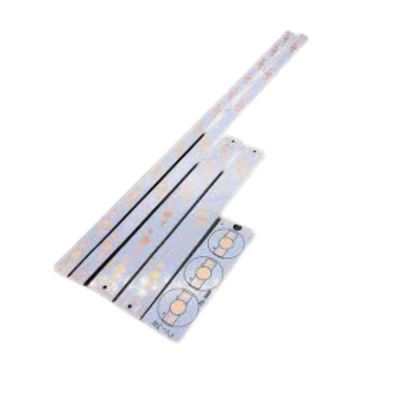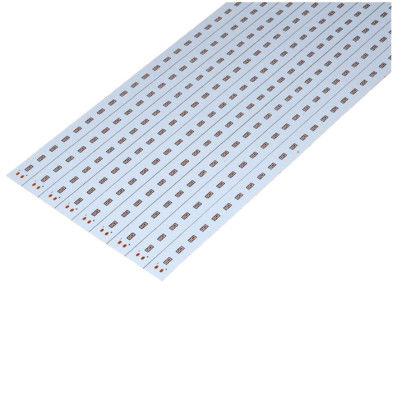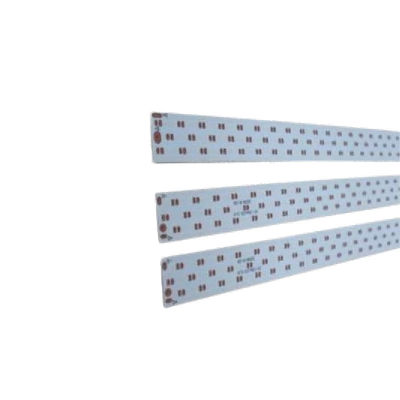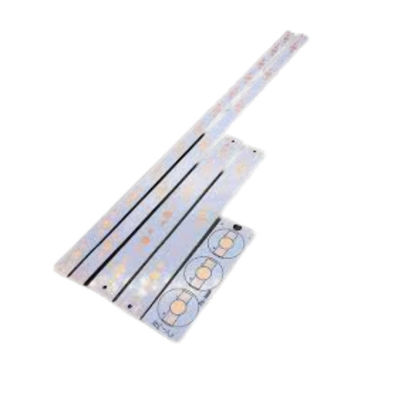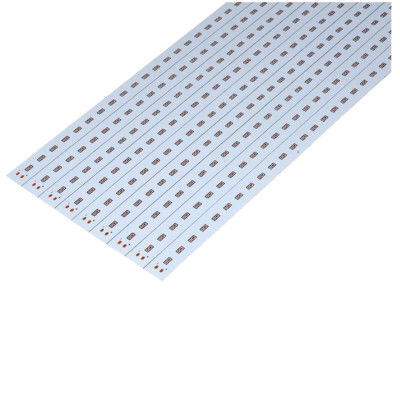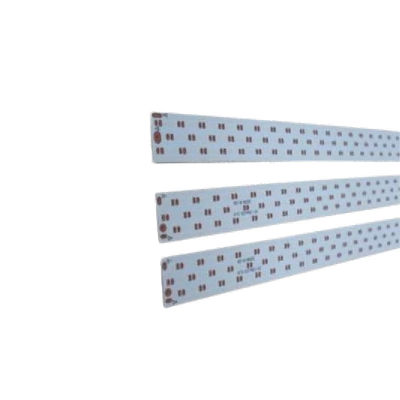Aluminum LED PCB Board Assembly Immersion Gold For Cabinet Light
| Place of Origin | Shenzhen |
|---|---|
| Brand Name | YScircuit |
| Certification | ISO9001,UL,REACH, RoHS |
| Model Number | YS-LE-0001 |
| Minimum Order Quantity | 1 piece |
| Price | 0.04-5$/piece |
| Packaging Details | Foam cotton + carton + strap |
| Delivery Time | 2-8 days |
| Payment Terms | T/T,PayPal, Alibaba pay |
| Supply Ability | 251,000 square meter/year |

Contact me for free samples and coupons.
Whatsapp:0086 18588475571
Wechat: 0086 18588475571
Skype: sales10@aixton.com
If you have any concern, we provide 24-hour online help.
x| Material | Metal | Size | 10-45cm |
|---|---|---|---|
| Process | Immersion Gold | Surface Finishing | HASL/HASL-LF/ENIG/OSP |
| Color | White | Thickness | 0.22cm |
| Application | Cabinet Light | Name | Cabinet Light Pcb |
| High Light | Cabinet Light LED PCB Board,Immersion Gold LED PCB Board,LED Aluminum PCB Assembly |
||
LED PCB Design Pcba Assembly Aluminum Printed Wiring Boards For Cabinet Light
PCBS FOR THE LED INDUSTRY
Printed circuit boards, or PCBs, are everywhere in our technology-based society.
Everything from computers to medical equipment to cars contains PCBs in one form or another.
However, PCBs are not all the same— each product is custom with different designs or materials and specifications to suit a unique purpose.
For circuit boards in the LED industry, the base material is especially important, which helps determine how effectively the circuit board transfers heat.
Some applications require specific properties in their circuit boards.
This is especially true for temperature-sensitive applications, one of which is LED lighting.
The LED lighting industry is expanding rapidly in response to increased interest in the more efficient and cost-effective lighting method, but much of the functionality of LED lights depends on the temperature of its system.
For many companies, the solution to this problem is aluminum-based PCBs.
To help you understand why the LED lighting industry uses PCBs, we’ve outlined the nature of base layers, the benefits of aluminum circuit boards and why they work well in the LED lighting industry.
![]()
WHAT IS AN LED PCB?
LED stands for light-emitting diode.
An LED printed circuit board is used to mount the diode(s) and power the LED for the application.
Generally, LED devices use a surface-mounted design (SMD) that includes a single LED component.
To generate more light, an LED circuit board connects multiple lights.
Because these lights and their operation generate a large amount of heat, they need to have a way to remove this heat, such as a heat sink or structural material that draws away heat.
Hence, the LED PCB material may be aluminum, which excels at transferring heat away from the board.
Due to the many advantages of LED lighting and its multiple applications in modern life, LED PCB manufacturing and products have increased to meet the rising demand.
FACTORS TO CONSIDER WHEN DESIGNING AN LED PCB BOARD
When designing an LED printed circuit board, you must think about the materials used, how to manage heat, trace routing and the finish.
With an appropriate design, a PCB manufacturer can create a board that will work as it should for operating the LED.
MATERIALS
Materials used for the printed circuit board should work together to remove and dissipate extra heat, insulate conductors, and allow electrical connections between LED components.
The base layer for many LED circuit boards uses aluminum.
Over the aluminum base is the dielectric layer, topped by the copper circuit layer and the solder mask.
This type of structure also goes by the term insulated metal substrate (IMS).
The aluminum base works well to release extra heat and assist in thermal management.
THERMAL MANAGEMENT
Thermal management is one of the most crucial aspects of LED design.
Poorly regulated temperatures can shorten the life of the device and affect the color purity of the light.
Therefore, designs of LED circuit boards typically include aluminum cores and heat sinks to get as much heat away from the components as possible.
The component arrangement and LED placement also impact the distribution and removal of heat to the air and should be part of the design considerations.
TRACE ROUTING
Proper trace routing design prevents open and short circuits, crosstalk between circuits and manufacturing problems.
Trace routing ensures that all network connections are properly attached without interference from other network connections.
Using the proper width of the traces prevents overheating.
Space for traces and mounting hole considerations in the design also ensure that problems will not happen during manufacturing.
FINISH
The board’s finish protects the circuit layer and ensures that assembly has a site for soldering components onto.
There are several types of printed circuit board finishes available, each with its own advantages and disadvantages.
Finding the right finish may involve discussing the expectations of the board and the budget for the project.
LED printed circuit board cores typically include either standard epoxy glass or metal cores. Heat transfer, as always, is crucial to maintaining the life of LED circuit boards.
However, epoxy glass cores can be more cost-effective.
METAL CORE
The most common metal core used for LED printed circuit boards is aluminum.
This metal quickly transfers heat away from the board to the outside.
In doing so, it augments the function of the board’s heat sink in preventing excessive heat from damaging the components of the circuit board.
These types of PCBs require surface mounted components because mounting anything through the board could lead to short circuits if the solder contacts the metal interior of the circuit board.
However, since LED components are surface mounted, metal cores suffice for their use.
STANDARD GLASS EPOXY
One of the biggest differences between metal and glass cores is their method of heat transfer.
For instance, metal cores do not use metal vias to conduct heat.
Instead, the aluminum does the work. For standard glass epoxy, metal vias carry heat away, though not as efficiently as metal core PCBs.
Unless cost-effectiveness is the most important component of designing an LED PCB, metal cores will perform better than standard glass epoxy cores.
| Layer | 1-24 |
| Material | Aluminum core (Domestic 1060), Copper core, FR4 covering |
| Thickness (Finished Board) | 0.8 mm-5.0 mm |
| Max. Board Size | 610 mm*610 mm |
| Copper weight (finished) | 0.5 oz-4.0 oz |
| Surface Finish | Hot air solder leveling (HASL) Lead-free HASL: RoHS compliant Electroless nickel/immersion gold (ENIG): RoHS compliant |
| Min. Tracing/Spacing | 4 mil/4 mil |
| Min. diameter of drill | 8mil |
| Min. Annular ring | 4mil |
| Soldermask Color | Green, red, black, yellow, white, blue, green matt, black matt |
| Silkscreen Legend Color | White, Black, Yellow |
| Countersink holes | Yes |
| Screw holes | Yes |
| layer/m² | S<1㎡ | S<3㎡ | S<6㎡ | S<10㎡ | S<13㎡ | S<16㎡ | S<20㎡ | S<30㎡ | S<40㎡ | S<50㎡ | S<65㎡ | S<85㎡ | S<100㎡ |
| 1L | 4wds | 6wds | 7wds | 7wds | 9wds | 9wds | 10wds | 10wds | 10wds | 12wds | 14wds | 15wds | 16wds |
| 2L | 4wds | 6wds | 9wds | 9wds | 11wds | 12wds | 13wds | 13wds | 15wds | 15wds | 15wds | 15wds | 18wds |
| 4L | 6wds | 8wds | 12wds | 12wds | 14wds | 14wds | 14wds | 14wds | 15wds | 20wds | 25wds | 25wds | 28wds |
| 6L | 7wds | 9wds | 13wds | 13wds | 17wds | 18wds | 20wds | 22wds | 24wds | 25wds | 26wds | 28wds | 30wds |
| 8L | 9wds | 12wds | 15wds | 18wds | 20wds | 20wds | 22wds | 24wds | 26wds | 27wds | 28wds | 30wds | 30wds |
| 10L | 10wds | 13wds | 17wds | 18wds | 20wds | 20wds | 22wds | 24wds | 26wds | 27wds | 28wds | 30wds | 30wds |
| 12L | 10wds | 15wds | 17wds | 18wds | 20wds | 20wds | 22wds | 24wds | 26wds | 27wds | 28wds | 30wds | 30wds |
| 14L | 10wds | 16wds | 17wds | 18wds | 20wds | 20wds | 22wds | 24wds | 26wds | 27wds | 28wds | 30wds | 30wds |
| 16L | 10wds | 16wds | 17wds | 18wds | 20wds | 20wds | 22wds | 24wds | 26wds | 27wds | 28wds | 30wds | 30wds |
![]()
![]()
![]()
![]()
![]()
FQA
1. The advantages of LED PCB
With the electronic products is more and more smaller and thinner, making it popular to use LED PCB, and there are various advantages with using LED PCB as follows:
- Lightweight, low profile
- dimensional stability
- thermal expansion
- heat dissipation
- Lower cost backlit membrane switch
- Dust and moisture resistant
- Make it easy to integrate into complex interface assemblies
- Efficient low power consumption
- Available in a wide variety of sizes, colors, and intensities
- May be used in silver flex membrane switches and copper flex membrane switches.
There are two main reasons which make the LED PCB be popular in addition to increasing the light output of the fixture with integrating multiple LED components.
- It’s easy to tune the color function by integrating the LED components with different color temperatures or different colors into the same PCB.
- It can achieve the various light fixtures to meet different lighting requirements with the boards that have different shapes, sizes and materials.
2. SMD LEDs in your PCB
There are many devices including LEDs on a PCB using surface mounted components.
If the wires are quite thin, through hole components can bend slightly so that it looks cheap from the outside.
If making it right to solder the SMD LED, it will be rigid on the board. What’s more, it can also place the SMD LED behind a screen, and cheaper LED that use a bulb will stick out through the packaging.
So it can place the SMD LED behind a small screen in your packaging to be cleaner for your device.
As you know, many PCBs that contain LEDs are fabricated with multilayer FR-4 substrates, so you need to have a pattern of closely-spaced filled or plated through vias under each component so that it can transmit heat, as well as get to your power and ground layers.
If your LEDs have a small footprint and are surfaced mounted, it can use our vias.
Probably there will be a weak solder joint or even tombstoning because it doesn’t fill or plate over the vias and then solder can wick into the vias during assembly, so the reason why it’s better to just use SMD LEDs on an LED lighting array is that the problem with wicking.
A single LED with decent power output will not lead to damaging to your board because of undue thermal.
However, if you are going to have a system for lighting applications, it will need to suffer from a massive heat for the board that supports your LEDs, and make it hard to cool with traditional methods for the boards.
Because the individual LEDs are too small, you can’t really attach a heatsink anywhere, and a heatsink will block the emitted light anyways.
Because there is a great demand on thermal, the boards with a metal core are usually used in LED lighting applications due to their ability to dissipate a great deal of heat.
In general, aluminum is used for LED lighting applications as the metal core in PCB.
What’s more, aluminum is the most metal used as the core among all the possible metal core PCBs.
As well as copper and iron are used for metal core PCBs.




